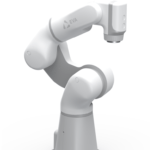What’s the story behind Fanuc cobots?

Fanuc is a Japanese company that has led the IT revolution in the industries. A pioneer in CNC machines in the 1950s, they manufactured the first industrial robots for the Japanese market in the 1970s.
In the 2000s, by partnering with General Motor, they simply became the world’s leading manufacturer of industrial robots in terms of sales volumes.
Seeing the emerging opportunities in cobotics, they launched their own cobot model in 2015, the CR-15iA. FANUC wanted to provide their customers with a safe and versatile automation tool within reach of their workers.
Based on their long-standing expertise in robotics, their cobot ranges then gradually expanded to support many industrial applications. In particular, they have been very successful thanks to the high durability of their materials and their ergonomics, but also thanks to the numerous Fanuc equipment.
Since then, in 2020, they have launched their augmented cobot models, the CRX. Their big selling point is their great ease of use and high performance. The CRX’s aim to meet the production needs of new-to-automation industries.
But do these new models from the historic manufacturer live up to their promise?
How to use a Fanuc CRX model?

After carefully unpacking the robot, you can immediately set it up on its stand and connect it with the controller and the interactive tablet. You can then switch on the robot and define the interface settings.
In the “Robot Operations” section, you can choose to guide the robot’s actions by hand or by joystick. In the first case, you can move the robot arm in three modes: completely free, in parallel with the axes, or in rotation. By staying on the dead man behind the tablet, you can then teach it each task step by step. In the second case, you must authorize the teaching mode to control the rotation and orientation of your robot remotely.
In all these manipulations, the system will constantly ask the user for the robot’s payload to ensure its safety.
To start programming, however, you must first set up the end effector on your robot. To do this, you need to put the weight of the tool, its center of gravity, and the center point of work, as well as its input and output.
When this is done, you can then go to the programming editor and define your first program. On it, you can apply various action blocks, such as moving, activating effectors and defining logical conditions. By turning on the forward mode, you can check if the movements are well-executed.
You can also connect and use the Fanuc IRVision module to perform applications such as Pick & Place in a more flexible way. You then need to calibrate the vision with a cell-shaped grid and make the robot adapt to the 2D cell location. When this is done, you need to train the robot with examples of your parts in different positions. The robot will then be able to grasp the right parts regardless of the position or viewing angle.
When you are sure of your program, you can launch the automatic mode, set the speed to 100%, and push on the start button. The robot will then perform the task in a loop.
What are the possible applications of the Fanuc CRX?

With a variety of effectors and good performance, Fanuc CRX can handle many applications:
- Pick & Place
- Machine loading
- Assembly
- Welding, painting and material distribution
- Packaging & Palletizing
- Sanding and Screwing
What about interaction with Fanuc CRX?

There are several reasons why Fanuc CRX is the perfect answer to the challenges of making automation accessible to all.
The first major strength is that this modernized version of FANUC cobots simply provides one of the most accessible user interfaces to data. The FANUC touchscreen tablet makes it easy to learn how to code a task visually, with smooth, clear menus. The programming features allow for relatively complex applications to be defined, and even the intelligent vision is accessible to knowledgeable workers. The hand control is intuitive and time-saving. Plus, the interface always considers user safety.
On the other hand, the Fanuc CRXs also stand out for their high application versatility. With compatibility with a wide range of Fanuc and partner accessories, the cobots can handle a wide range of tasks. By supporting mobile platforms, they can also be easily carried from one end of the production line to the other.
While they may still lack more intelligent functionality (such as for quality control of parts), they meet basic industrial applications. Their great reach and load characteristics and Fanuc’s own build quality help with this.
Our ratings
Overall
-
Performance
-
Usabillity
-
Safety
-
Versatility
What to make of FANUC CRX ?
Overall, Fanuc CRX is an ambitious successor to the CR, targeting industries that want to move into automation. Although Fanuc CRX might not handle specialized applications for some companies, it is a good first choice for small and medium industries.





